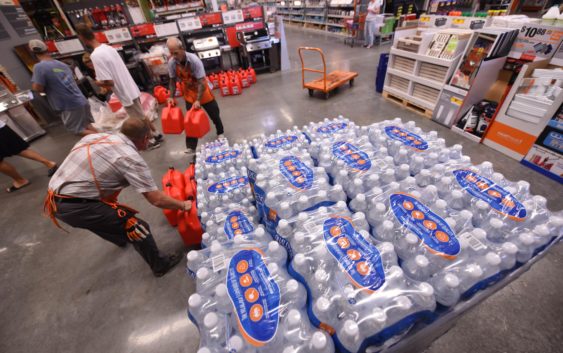- One set of evacuation orders lifted in Caldwell County after wildfire contained
- 'We gutted every building' | Chimney Rock rebuilding after Hurricane Helene
- 'We gutted every building' | Chimney Rock rebuilding after Hurricane Helene
- Debris from Hurricane Helene provides fuel, complicates containment for spring wildfires
- David & Nicole Tepper increase Hurricane Helene relief commitment to $750k
Wilmington in Hurricane Dorian cone of uncertainty

N.C. Gov. Roy Cooper declared a state of emergency Friday to allow farmers to prepare for any potential impacts next week
Gov. Roy Cooper declared a state of emergency for North Carolina on Friday afternoon ahead of the potential impacts the state could feel from Hurricane Dorian next week.
By Friday afternoon, Dorian was officially on track to hit the eastern coast of Florida sometime late Monday or early Tuesday, possibly as a monster category 4 storm.
As of 2 p.m. Friday, the hurricane was still a category 3 with 115 mph sustained winds as it churned its way to Florida. According to the National Weather Service (NWS) in Wilmington, Dorian’s motion is expected to slow down once it gets to Florida and then possibly turn up the East Coast by the middle of next week.
Although the storm is too far away to make concrete predictions about the impacts that could be seen on the North Carolina coast, Cooper’s declaration waives certain transportation restrictions to help farmers and support relief efforts in advance of the storm.
“Hurricane Dorian tracking toward the coast of Florida is a timely reminder to get your emergency plans and supplies ready,” Cooper said in a release. “North Carolinians should make sure they are ready for this storm and for all types of emergencies and disasters.”
Dorian’s track is still uncertain, but forecasters are warning it’s possible the storm will bring significant rainfall to the Cape Fear region by late next week.
At 3 p.m. Friday, Brunswick County issued a statement citing the NWS’ immediate concerns as ongoing tidal/coastal flooding and the increased threat for rip currents during Labor Day weekend. Coastal North Carolina residents who hit the beaches for the long weekend should be on the lookout for rough surf and strengthening rip currents beginning Saturday.
University of North Carolina Wilmington announced Friday it was monitoring the storm but did not anticipate any closures or delays early next week.
More long-range concerns through late next week could include flooding, rain, storm surges, tornadoes and damaging winds — all depending on how Dorian’s track develops over the coming days.
Due to the high uncertainty of the storm’s path, coastal residents should prepare their hurricane kits now and continue to monitor the storm throughout the weekend.
Stay up to date on news as it happens: Sign up for our free breaking news email alerts
How to prepare before a storm hits:
Necessities
• Water. 1 gallon per person, per day, prepare for a minimum of three days.
• Battery-operated television or radio.
• Extra batteries
• Manual can opener
• Local maps
• Flashlights and waterproof matches
• Cellphone with chargers, inverter or solar charger
• Toilet paper
• Baby supplies
• Cash (ATMs may not work after the storm)
• Rain gear (including a hat)
• Bleach or water purification tablets
• Soap and detergent
• Moist towelettes, garbage bags and plastic ties for personal sanitation.
• Charcoal/lighter fluid or portable camping stove
• Disposable plates, glasses and utensils
• Ice chest and ice
• Valuable papers — insurance information, passports, Social Security cards, bank account and credit card numbers, wills, deeds, etc. — or copies, in a waterproof bag
• Prescription and other necessary medicines
• Blankets, tarp and masking tape
• Dust mask to filter contaminated air, plastic sheeting and duct tape.
• Three day’s worth of clothing, sleeping bags
• First-aid kit, aspirin or pain reliever, anti-diarrhea medication, scissors, tweezers, bug spray
• Feminine supplies and personal hygiene items
• Fire extinguisher — ABC type
• Extra pair of eyeglasses
• Extra house, car keys
• Tools: Shut-off wrench, pliers
• Needles, thread
• Whistle
• Signal flare
• Games,books for entertainment
• Petcare: leashes, pet carriers, food
• Sunscreen and sunglasses
Food
• Baby food, baby formula, powdered milk
• Canned meats (Spam, chicken, ham)
• Canned fish (tuna, sardines)
• Canned meals: spaghetti, soup, stew, chili
• Canned fruits and vegetables
• Cereal, crackers and cookies
• Instant coffee, tea bags, sodas, juice
• Granola bars, nuts, trail mix
• Peanut butter and jelly
• Sugar, salt, pepper
Sources: American Red Cross; FEMA; N.C. Emergency Management